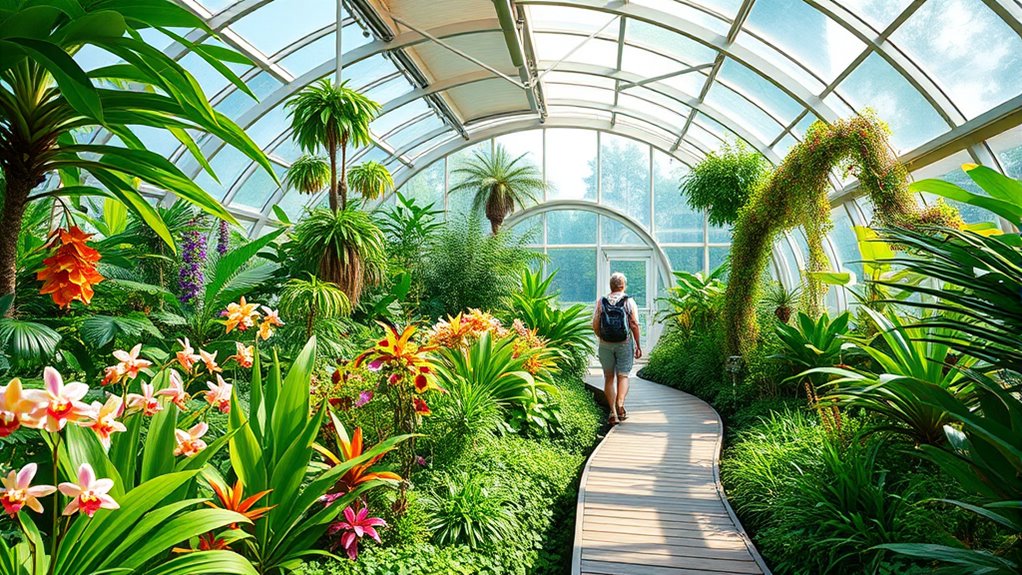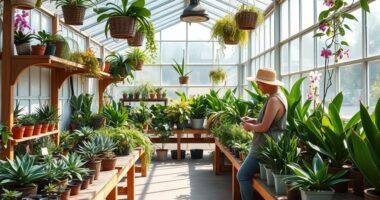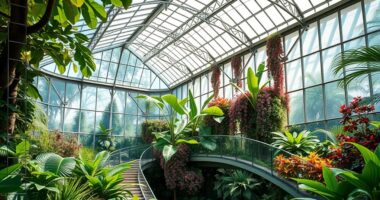Around the world, innovative greenhouse projects showcase sustainability and advanced design. You’ll see structures using curved roofs, natural ventilation, and thermal mass for ideal climate control. Many incorporate solar panels, recycled materials, and water-saving features like rainwater harvesting. In arid regions, reflective surfaces boost sunlight, while colder climates use double-glazing and energy-efficient lighting. These projects highlight how eco-friendly technology is shaping resilient, productive farming systems—keep exploring to learn about the most inspiring examples.
Key Takeaways
- Innovative greenhouses incorporate natural ventilation, curved roofs, and thermal mass for optimal climate control and energy efficiency.
- Use of sustainable materials like polycarbonate panels and transparent solar panels enhances durability and renewable energy generation.
- Projects in arid regions utilize reflective surfaces and water harvesting systems to maximize sunlight and conserve resources.
- Cold climate greenhouses feature double-glazing and thermal curtains to maintain internal warmth sustainably.
- Globally, greenhouses integrate solar energy, rainwater harvesting, and shading techniques to boost resilience and food security.

Have you ever wondered how different countries harness greenhouses to boost agriculture and sustainability? Across the globe, innovative greenhouse projects are transforming traditional farming by integrating sustainable design principles and cutting-edge materials. These efforts aim to maximize crop yields while minimizing environmental impact, showing that technology and eco-conscious strategies can work hand in hand. As you explore these projects, you’ll see how each location adapts its approach based on climate, resources, and cultural context, but all share a common goal: creating resilient, efficient food production systems.
Discover how global greenhouses innovate with sustainable design and materials to transform agriculture and promote resilience.
One standout aspect of these greenhouses is their emphasis on sustainable design. Instead of relying solely on conventional structures, many projects incorporate features like natural ventilation, rainwater harvesting, and energy-efficient lighting. These elements reduce reliance on external energy sources and help conserve water, making the systems more eco-friendly. For example, some greenhouses are built with curved roofs that facilitate airflow and temperature regulation naturally, lowering the need for mechanical cooling or heating. Others utilize shading techniques or thermal mass materials that absorb heat during the day and release it at night, maintaining a stable environment for crops. This thoughtful integration of sustainable design principles ensures that the greenhouse operates efficiently while reducing its carbon footprint. Additionally, the use of solar panels with battery storage allows these projects to generate and store renewable energy, further decreasing dependence on non-renewable sources.
Innovative materials play a pivotal role in these pioneering projects. Traditional glass or plastic covers are being replaced with newer, more durable options that offer better insulation and light diffusion. Polycarbonate panels, for instance, are lightweight yet strong, providing excellent insulation and UV protection. Some projects are experimenting with bio-based plastics or recycled materials to further reduce environmental impact. The use of these innovative materials not only enhances the durability of the structures but also improves their energy efficiency. In certain cases, the incorporation of transparent solar panels allows greenhouses to generate their own electricity while letting in the sunlight needed for plant growth. These advancements demonstrate how material science is driving a new era of sustainable, high-performance greenhouses.
You’ll also notice that these projects often combine technology with local knowledge. In arid regions, greenhouses use reflective materials to maximize sunlight while minimizing heat gain, while in colder climates, double-glazing and thermal curtains help retain warmth. By blending innovative materials with sustainable design, each project becomes uniquely tailored to its environment, ensuring maximum productivity and minimal environmental impact. As you follow these global examples, it’s clear that the future of agriculture lies in smart, sustainable greenhouses that leverage innovation at every level. This approach not only boosts food security but also paves the way for a more resilient, eco-friendly world.
Frequently Asked Questions
How Do Greenhouse Designs Vary Across Different Climates?
You’ll notice greenhouse designs vary greatly across different climates to suit local conditions. In hot environments, climate adaptation includes reflective roofs and shading to reduce heat, while cold regions benefit from insulated walls and energy-efficient heating. Architectural innovations like double-glazed panels or passive solar features help optimize temperature control. By customizing designs, you maximize crop growth and resource efficiency, making greenhouses more effective regardless of their climate.
What Sustainable Materials Are Commonly Used in These Projects?
Think of sustainable materials like the roots anchoring a tree—they’re essential for eco-friendly construction. You’ll often see recycled wood, bamboo, and reclaimed metal used in greenhouse projects, symbolizing growth and renewal. These materials not only reduce environmental impact but also promote durability. By choosing eco-friendly construction, you guarantee your project supports sustainability, much like a tree thriving with healthy roots—strong, resilient, and environmentally harmonious.
How Do Local Communities Benefit From These Greenhouses?
You see, local communities benefit greatly from greenhouses through community engagement and economic empowerment. These projects create jobs, improve local food security, and foster skills development. By involving residents in the design and maintenance, they feel more invested and proud. The increased access to fresh produce boosts health, while new income opportunities help lift families out of poverty, making greenhouses essential for sustainable community growth.
What Are the Initial Costs Associated With Building Innovative Greenhouses?
You’re jumping in at the deep end, so it’s essential to understand the initial costs of innovative greenhouses. You’ll need to do a thorough cost estimation, considering materials, technology, and labor. Funding sources vary, including grants, loans, or community investments. While costs can seem steep upfront, a well-planned budget ensures you’re prepared, helping your project get off the ground and thrive in the long run.
How Do These Projects Address Water Conservation Challenges?
You can address water conservation challenges by implementing rainwater harvesting and greywater recycling systems in your greenhouse. Rainwater harvesting captures and stores rainwater for irrigation, reducing reliance on external sources. Greywater recycling treats and reuses water from sinks or showers, minimizing waste. These innovative methods help conserve water, lower costs, and promote sustainability, ensuring your greenhouse operates efficiently while protecting essential water resources.
Conclusion
So, seize these spectacular stories of sustainable success and start your own greenhouse journey. From futuristic farms to flourishing food sources, these projects prove passion and perseverance plant powerful progress. Let these lush landscapes inspire innovation, ignite ideas, and ignite your inner eco-enthusiast. Remember, with dedication and determination, your greenhouse goals can grow into glorious green gardens that gift the globe with green goodness. Go ahead—gather grit, grow greatness, and glow green!









